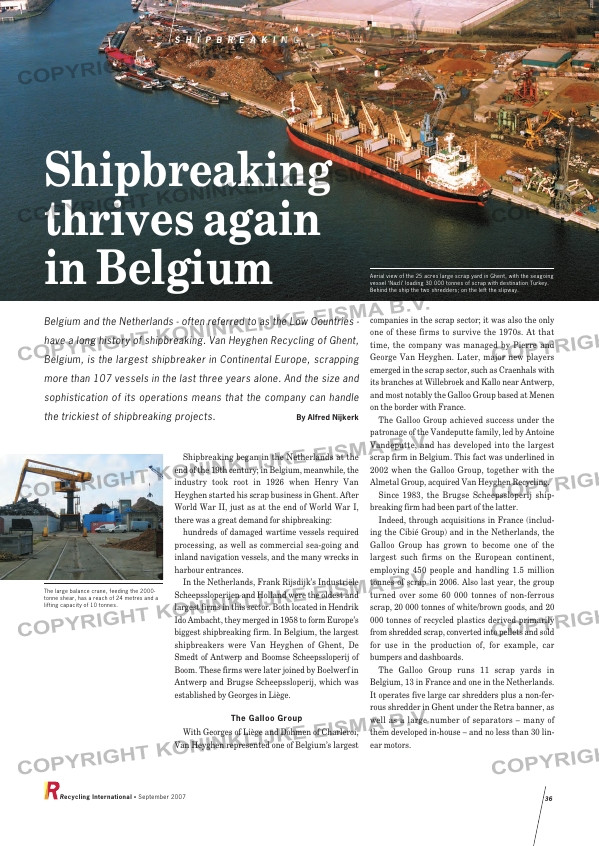Page 36 from: September 2007

Shipbreaking began in the Netherlands at the
end of the 19th century; in Belgium, meanwhile, the
industry took root in 1926 when Henry Van
Heyghen started his scrap business in Ghent. After
World War II, just as at the end of World War I,
there was a great demand for shipbreaking:
hundreds of damaged wartime vessels required
processing, as well as commercial sea-going and
inland navigation vessels, and the many wrecks in
harbour entrances.
In the Netherlands, Frank Rijsdijk’s Industriële
Scheepssloperijen and Holland were the oldest and
largest firms in this sector. Both located in Hendrik
Ido Ambacht, they merged in 1958 to form Europe’s
biggest shipbreaking firm. In Belgium, the largest
shipbreakers were Van Heyghen of Ghent, De
Smedt of Antwerp and Boomse Scheepssloperij of
Boom. These firms were later joined by Boelwerf in
Antwerp and Brugse Scheepssloperij, which was
established by Georges in Liège.
The Galloo Group
With Georges of Liège and Dohmen of Charleroi,
Van Heyghen represented one of Belgium’s largest
companies in the scrap sector; it was also the only
one of these firms to survive the 1970s. At that
time, the company was managed by Pierre and
George Van Heyghen. Later, major new players
emerged in the scrap sector, such as Craenhals with
its branches at Willebroek and Kallo near Antwerp,
and most notably the Galloo Group based at Menen
on the border with France.
The Galloo Group achieved success under the
patronage of the Vandeputte family, led by Antoine
Vandeputte, and has developed into the largest
scrap firm in Belgium. This fact was underlined in
2002 when the Galloo Group, together with the
Almetal Group, acquired Van Heyghen Recycling.
Since 1983, the Brugse Scheepssloperij ship-
breaking firm had been part of the latter.
Indeed, through acquisitions in France (includ-
ing the Cibié Group) and in the Netherlands, the
Galloo Group has grown to become one of the
largest such firms on the European continent,
employing 450 people and handling 1.5 million
tonnes of scrap in 2006. Also last year, the group
turned over some 60 000 tonnes of non-ferrous
scrap, 20 000 tonnes of white/brown goods, and 20
000 tonnes of recycled plastics derived primarily
from shredded scrap, converted into pellets and sold
for use in the production of, for example, car
bumpers and dashboards.
The Galloo Group runs 11 scrap yards in
Belgium, 13 in France and one in the Netherlands.
It operates five large car shredders plus a non-fer-
rous shredder in Ghent under the Retra banner, as
well as a large number of separators – many of
them developed in-house – and no less than 30 lin-
ear motors.
Recycling International • September 2007 36
Shipbreaking
thrives again
in Belgium
Belgium and the Netherlands – often referred to as the Low Countries –
have a long history of shipbreaking. Van Heyghen Recycling of Ghent,
Belgium, is the largest shipbreaker in Continental Europe, scrapping
more than 107 vessels in the last three years alone. And the size and
sophistication of its operations means that the company can handle
the trickiest of shipbreaking projects. By Alfred Nijkerk
S H I P B R E A K I N G
Aerial view of the 25 acres large scrap yard in Ghent, with the seagoing
vessel ‘Nazli’ loading 30 000 tonnes of scrap with destination Turkey.
Behind the ship the two shredders; on the left the slipway.
The large balance crane, feeding the 2000-
tonne shear, has a reach of 24 metres and a
lifting capacity of 10 tonnes.
RI_014 Shipbreaking:Opmaak 1 05-09-2007 12:49 Pagina 36



